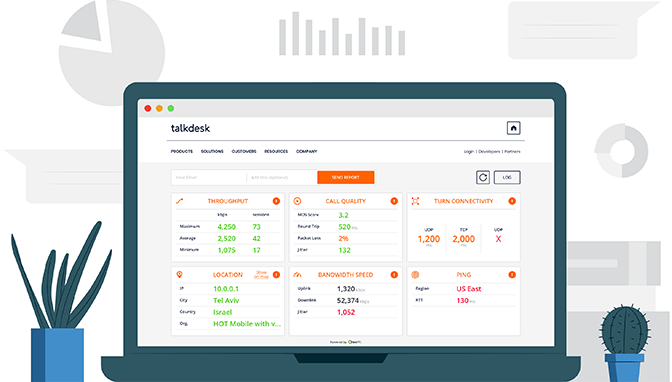Effectively test and validate your WebRTC application with ease
testingRTC simplifies testing WebRTC applications and infrastructure by systematically automating browsers on demand and at scale.

How do you know how many streams your WebRTC media server supports?
Can you perform the same test scenario over and over again with a predictable outcome?
Did you test your WebRTC service in different network conditions?
Do you automate your regression tests as part of your release cycles?
Developing WebRTC applications is hard and testing them is even harder. Testing can be quite daunting, especially when repeat tests are needed as the application is continuously developed, modified and improved.
The need for powerful client machines, as well as an understanding of WebRTC behavior and statistics, makes generic web testing platforms useless for WebRTC testing, often requiring custom infrastructure to be built from scratch or heavy reliance on manual testing. Both of these options consume valuable time and resources.
Wouldn’t it be better if you had a solution that provides you with WebRTC focused browser automation to cover your infrastructure testing needs?
What should you look for in a WebRTC testing solution?
- Scalable - A tool that can be used to run workloads with any number of browsers, spread globally, on demand, whenever you need it. All in a predictable and reproducible manner.
- Focused - Provides mechanisms that are necessary in modern WebRTC implementations; including configuring network conditions dynamically, message passing and synchronization across browsers, and much more.
- Detailed - Collects anything and everything that relates to WebRTC, making it easily viewable, from a top level view of the results of a large stress test to drilling down to the events and specific metrics you need on a single instance level.
What you really need is a tool that lets you increase your development cycles by creating faster feedback loops from development to testing, especially during optimization phases and new version releases and updates.
Introducing: testingRTC - a powerful WebRTC test automation tool
testingRTC is a browser automation tool focused on your WebRTC testing needs. By automating web browsers, you can simulate real users using your service from different locations around the world, running on different network configurations, all done at scale in a reproducible fashion - so you can test, debug, validate and optimize your application efficiently.
testingRTC is part of our complete suite of quality assurance solutions. testRTC enables testing, monitoring and supporting WebRTC based applications and services.
Developed by WebRTC experts
testingRTC offers the most comprehensive WebRTC testing service, designed and built by WebRTC experts for WebRTC developers.
“
“testRTC is the defacto standard for providing reliable WebRTC testing functionality and is used today at Vowel by most of the engineering team.
For Vowel, testRTC is extremely fast and easy to use.
It is easy to automate and spin up tests on demand with just a click of the button, no matter the scale needed.”
Paul Fisher
CTO and Co-Founder at
Ensure your WebRTC application works flawlessly for your customers
Find bugs sooner and faster
Get better coverage of your test plan, focusing on the behavior of your WebRTC infrastructure, preparing for the inevitable growth of your service.
Plan, schedule and automate
Write scripts once and run them multiple times, scaling them up and down with the needs of your WebRTC application. By using the test editor you will be able to quickly change a test’s behavior and size, enhancing your test coverage.
Validate and measure performance
With testingRTC you can define your own thresholds and expectations, indicating what your pass criteria is based on WebRTC quality metrics applicable to your application.
WebRTC test types
testingRTC lets you conduct the following types of tests scenarios
What does testingRTC include?
Try out testingRTC today
You can start writing your first WebRTC test script and reap the benefits of automation today.

Yes.
testingRTC works by automating web browsers. As long as your application has a web page that users interact with, testingRTC can be used to test it.
Our service is being used by clients who are developing their applications using Jitsi, Janus, mediasoup, FreeSWITCH, OpenTok, Twilio, LiveSwitch, Agora and many other frameworks.
In general, testingRTC is a self-service platform. You can write and run any test script you need without interacting with us too much. To that end, we offer an extensive knowledge base documentation.
If you don’t have the skills or the time to handle scripting, we can offer it via our professional services.
We offer automated testing solutions on Chrome and Firefox. For the most part, our focus with testingRTC has always been testing and validating WebRTC infrastructure.
If you need assistance with your testing on other platforms and browsers, then watchRTC can complement your manual testing as well.Selenium Grid is great for browser automation, but it doesn’t have any knowledge or understanding of WebRTC.
testingRTC has 3 critical pieces that Selenium Grid misses:
Machine, peripherals and network configurations suitable for conducting WebRTC testing
Specific controls for interactive applications, such as synchronizing between browsers (a patient joining a session only after a doctor logs in for example)
Collection, assertions and analysis of WebRTC specific metrics, which lets face it - is what we’re here for to begin with
Yes.
We offer multiple ways to export results from the tests you conduct. From collecting results directly from webhooks, through using our REST API to downloading results in CSV format.
Depends on the plan and amount of testing you need.
Let’s talk and see how we can work together.
SEE HOW testRTC CAN HELP YOUR BUSINESS
Want to learn more about testRTC and what we do?
Address: 68 Kaplan st, Qiryat Ono, 5529368, Isreal
Phone: +972-3-721-9301
Email: [email protected]

